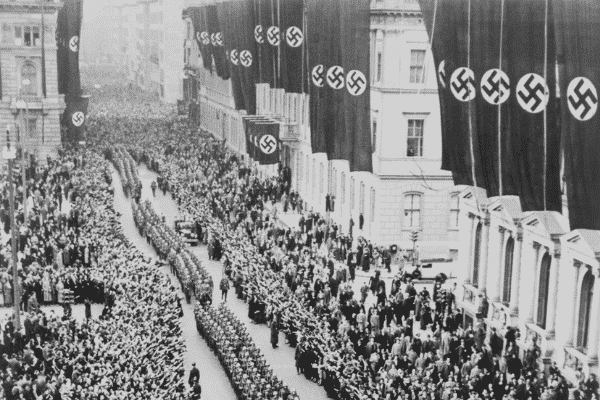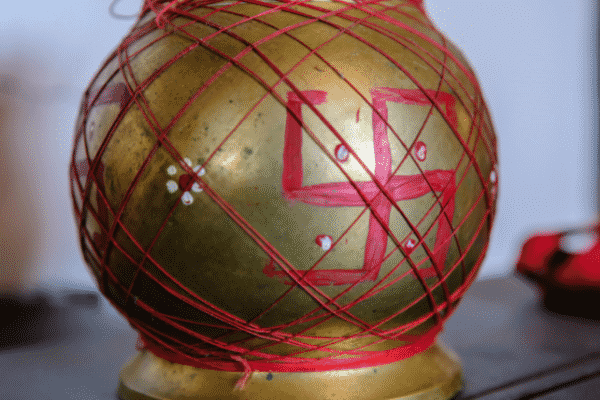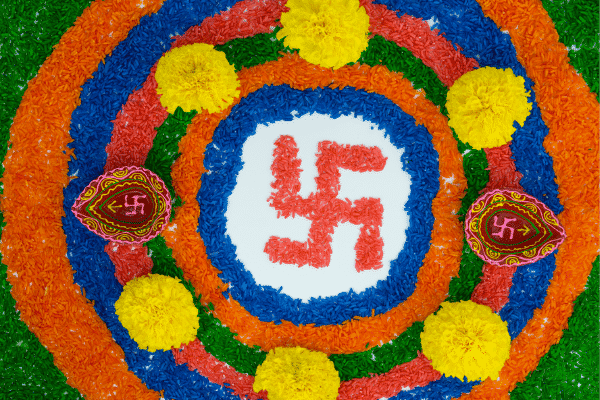There is concern in the Hindu community in Australia at the recent announcement regarding strengthening Victoria’s anti-vilification laws. It’s a move rightfully intended to put a stop to extremism and propaganda, like Nazi symbols, but it is unnerving for Hindus, for whom the swastika is an ancient, sacred symbol.
Announced on 2 September, the landmark reform aims to curb hateful behaviour and make civil and criminal vilification easier to prove in courts. Expected to be introduced in early 2022, it could mean consequences of almost $10,000 fines or six months imprisonment, as reported by the ABC.
AT A GLANCE
- The state of Victoria is set to ban the public display of the Nazi swastika as part of an expansion of anti-vilification laws.
- The Hindu community at large knows the Swastika as an ancient sacred symbol which the Nazis misappropriated.
- A ban will impact Hindu cultural practices and religious ceremonies.
“All forms of hate are unacceptable and have no place in Victoria – expanding our anti-vilification laws to protect more Victorians sends a clear message that this vile behaviour will not be tolerated,” explained Attorney-General Jaclyn Symes.
This includes the Nazi swastika, which glorifies “one of the most hateful ideologies in human history,” said Minister for Multicultural Affairs Ros Spence.

In the modern world, the Swastika is a symbol of hatred and violence. So synonymous is it with fascism that its original meaning stands obliterated in the western world. However, for Australia’s nearly 450,000 Hindus (as of the 2016 census), the swastika is a symbol of good fortune and wellness.
Growing up in Hindu families, many of us knew of it first as a sacred symbol of all good things, and only much later as symbol that the Nazis stole.
The Sanskrit term ‘swastika’ comes from the combination of two root words Su (meaning good) and Asti (meaning existence) and as such, refers to wellbeing. The four ‘arms’ signify wellness or good form in the four basic endeavours of human life – moral, economic, emotional and spiritual (which Hindu readers may know of as Dharma, Artha, Kama and Moksha). In this sense, the sacred Hindu symbol is the very antithesis of what the Nazis intended it to be.

To the untrained eye, the symbols may look alike, but there is a difference in the iconography of the Nazi Hakenkreuz (hooked cross) and the Hindu swastika. The Nazi symbol is black and tilted, on a distinctive white circle and red background. In his autobiographical manifesto Mein Kampf, Hitler elaborated that the red symbolised social thought while the white national thought. The swastika in the middle signified his ‘mission’ – “the struggle for the victory of Aryan mankind and at the same time the triumph of the ideal of creative work.”
Thus, the Nazi misappropriation has seen the original significance of the swastika turn head over heels.
At a Sydney Dance Company production only months ago, when contemporary dance performer Raghav Handa attempted a re-sanctification, one cast member opted out because they were not comfortable with the theme of the Swastika. When it finally did go ahead, the show came with a content warning: The work contains images of the swastika. … Patrons (have) the opportunity to leave the theatre if they wish.
In November 2013, a well-meaning but controversial “Learn to Love The Swastika Day” even saw tattoo artists around the world offer free swastikas. It was an attempt to embrace the symbol’s multicultural past rather than its fascist connotations, but it drew massive criticism and was ultimately shut down.
How the ban will impact Hindus
For Hindus, the Swastika is a symbol of blessing that has been used for thousands of years. It marks the opening pages of books, thresholds, doors, even events.
“Visit any Hindu home, and you’ll find the Swastika – often at the entrance,” said Prakash Mehta, President of the Hindu Council of Australia.
“We use it at the commencement of our religious rituals. But equally, (in our daily lives) we use it as decoration, at weddings, in our vehicles. This practice has been continuously followed for thousands of years. Hence a ban will greatly impact Hindus, for performing not only their religious ceremonies, but also to follow their cultural practices.”

It’s crucial to note that the Victorian Government has not categorically banned the swastika and the recommendation to ban the symbol has some considerations for exceptions.
“Hindu Council of Australia (Victoria) made submissions to the enquiry into the Anti-Vilification process. However, the terms of reference were related to anti-Semitism and the potential prohibition of the Swastika symbol was not identified at the time,” Mehta noted.
“When the anti-vilification report was published in April 2021, the reference to the Swastika was noticed. The Hindu Council immediately made a submission to the Victorian Multicultural Commission… We received assurance then that the Hindu community would be consulted. However, Hindu community is disappointed to note that there are no references to this in the (recent) announcement.”
The Hindu Council of Australia and other Hindu organisations are expected to make submissions that will elaborate and specify the usage of the symbol for all applications related to Hindu faith.
Earlier this year, in an exclusive interview with Indian Link, Minister for Immigration, Migrant Services, and Multicultural Affairs Alex Hawke was quick to note the difference between the two symbols.
“Obviously the swastika is a different symbol to the ancient Hindu symbol used for many thousands of years. We’re very sensitive to that issue as well. The swastika can be a rallying point for right-wing extremism, and therefore if we receive advice to remove those rallying points, we will be in favour of that, but it will not affect the faith symbols. I’ve seen them in Hindu temples and people’s houses, the misappropriation of that ancient symbol by the Nazis is a tragedy,” he told Indian Link’s Pawan Luthra.

When asked about preserving the Hindu symbol, he confirmed that the Federal Government plans to take that approach.
“The ban of the swastika is meant to be a ban on rallying of Nazism, not to target other people’s faiths. We are an intelligent country, and we can identify the difference between the two symbols,” he insisted.
Still, there have been unfortunate incidents in the past when well-meaning Australians have found themselves at odds with the swastika, most recently in 2019 when a Hindu family’s Diwali rangoli was destroyed by an Adelaide delivery man who thought it to be the anti-Semitic symbol.
“The identification of the difference between the two symbols is to be done through community awareness and education to be imparted to the implementing agencies,” said Hindu Council of Australia’s Prakash Mehta. “(We) will undertake at an appropriate time this activity to clearly distinguish between the two symbols.”
It’s clear that there has been a gross misappropriation of the swastika and the Victorian Government’s recent reform, while well-intentioned and necessary, is understandably unsettling for the state’s Hindus. Has the time finally come to de-weaponise the Swastika?
READ ALSO:
Link up with us!
Indian Link News website: Save our website as a bookmark
Indian Link E-Newsletter: Subscribe to our weekly e-newsletter
Indian Link Newspaper: Click here to read our e-paper
Indian Link app: Download our app from Apple’s App Store or Google Play and subscribe to the alerts
Facebook: facebook.com/IndianLinkAustralia/
Twitter: @indian_link
Instagram: @indianlink
LinkedIn: linkedin.com/IndianLinkMediaGroup




